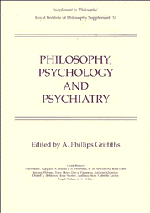Book contents
- Frontmatter
- Contents
- Preface
- Introduction: Just Getting Started
- Mind and Madness: New Directions in the Philosophy of Psychiatry
- Emotion and Memory: The Second Cognitive Revolution
- Meaning and Mechanism in Psychotherapy and General Psychiatry
- Making Sense on the Boundaries: On Moving Between Philosophy and Psychotherapy
- Mental Disorder, Illness and Biological Disfunction
- Integrity, Boundary and the Ecology of Personal Processes
- Multiple Personality and Computational Models
- Psychology and Politics: Lies, Damned Lies and Self-Deception
- Personal Identity and Psychiatric Illness
- Vices and the Self
- Wild Beasts and Idle Humours: Legal Insanity and the Finding of Fault
- Dangerousness and Mental Disorder
- Problems with the Doctrine of Consent
- Homosexuality
- Nietzsche and Music
- References
- Notes on Contributors
Making Sense on the Boundaries: On Moving Between Philosophy and Psychotherapy
Published online by Cambridge University Press: 03 May 2011
- Frontmatter
- Contents
- Preface
- Introduction: Just Getting Started
- Mind and Madness: New Directions in the Philosophy of Psychiatry
- Emotion and Memory: The Second Cognitive Revolution
- Meaning and Mechanism in Psychotherapy and General Psychiatry
- Making Sense on the Boundaries: On Moving Between Philosophy and Psychotherapy
- Mental Disorder, Illness and Biological Disfunction
- Integrity, Boundary and the Ecology of Personal Processes
- Multiple Personality and Computational Models
- Psychology and Politics: Lies, Damned Lies and Self-Deception
- Personal Identity and Psychiatric Illness
- Vices and the Self
- Wild Beasts and Idle Humours: Legal Insanity and the Finding of Fault
- Dangerousness and Mental Disorder
- Problems with the Doctrine of Consent
- Homosexuality
- Nietzsche and Music
- References
- Notes on Contributors
Summary
The philosopher is the man who has to cure himself of many sicknesses of the understanding before he can arrive at the notions of the sound human understanding.
(Wittgenstein, 1967, no.302)The work of a philosopher consists in assembling reminders for a particular purpose.
(Wittgenstein, 1953, no. 127).A new word is like a new seed sown on the ground of discussion.
(Wittgenstein, 1980, p. 2e).The aim of the series of lectures, from which this article derives, was (to quote the invitation I received): ‘to enhance the effectiveness of [among others] mental health practitioners … by illuminating the philosophical in these activities: and to advance philosophical theory by making the phenomena of psychiatry and clinical psychology more accessible to philosophers’. And I have done my best to fulfil this aim. There is, however, a word within the statement above that bothers me: it is the word ‘theory’. In the past, we have been very used to both distinguishing between, and valuing, theory over practice, with philosophers (and pure scientists) supposedly finding correct theories, and practitioners, as like shopfloor workers, supposedly applying the theories handed down to them. Thus, in these more financially stringent times (the invitation seemed to suggest), philosophy really ought to pay its way a little more by orienting its ‘theories’ to, perhaps, more practical issues.
- Type
- Chapter
- Information
- Philosophy, Psychology and Psychiatry , pp. 55 - 72Publisher: Cambridge University PressPrint publication year: 1995



